An Uncertain Interlude
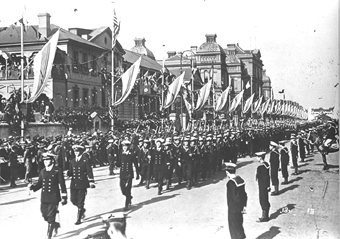 Peace after WWI is celebrated in a parade seen here marching past New South Wales Parliament House in Macquarie Street, Sydney
Peace after WWI is celebrated in a parade seen here marching past New South Wales Parliament House in Macquarie Street, Sydney
The twenties were a mixed period of some prosperity undermined by disappointment and growing uncertainty. Unemployment remained high (often around 10%) as hundreds of thousands of veterans returned expecting life to be better and looking for work. Social programs including housing and soldier farm settlement schemes were initiated by governments in a stop-start manner. Many thousands of other ex-soldiers faced permanent disability and degeneration as a result of war injuries, and the great influenza epidemic of 1919-1920 had capped off the massive wartime casualties with thousands more deaths.
The political parties recovered from the wartime split or reinvented themselves and Governments changed at most elections – there were 8 changes of Premier in 10 years (on one occasion the Government changed three times in one day – see ‘A Day of Changes’ below). The electoral system was experimented with, social reforms such as widow’s pensions, child endowment, shortening the working week and workers’ compensation were introduced, mostly by Labor governments. A massive public works program to build the Sydney Harbour Bridge, the underground railway system and railway electrification complimented the rapid expansion of suburban Sydney as new suburbs sprang up west, north and east of the city centre. This program was largely funded through overseas loans, which were to become part of the 1930s crisis to come. There was significant industrial growth in New South Wales but the state still depended largely on its agricultural output and exports.
Changing the Electoral System
At the beginning of the twentieth century, voting was by the
first-past-the-post system whereby the winning candidate was simply the one with the largest number of votes. A candidate with 30% of the votes would win if that was the highest number, even though 70% of the electorate had actually voted against him. In 1910, a second ballot was introduced in instances where no candidate had an absolute majority. From 1918 to 1926 a
proportional representation system was tried, with multiple representatives from each electorate. It proved very difficult to administer and was replaced by
optional preferential voting in 1926 and a return to single member electorates. This almost immediately led to
compulsory preferential voting in 1928. This required the voter to vote for all candidates in order of the voter's own preference. If no single candidate has a clear majority, the votes of candidates with the smallest first preference total are passed on to their second preferences and so on until someone does have a clear majority. In 1979, the New South Wales system was modified to allow
optional preferential, whereby a first preference only, or that and as many subsequent consecutive preferences as the voter chooses, could be shown by the voter.
Postal votes were introduced in 1918 and voting was made compulsory in New South Wales in 1928. Until 1979 electoral distribution favoured the non-metropolitan areas of the State. All electorates, rural and urban, are now required to have approximately equal numbers of electors.
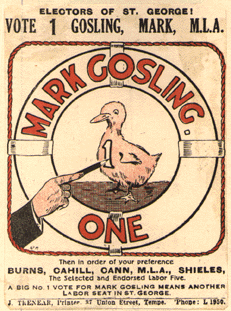 At the New South Wales elections of 1926, with a return to single member electorates, candidate Mark Gosling succeeded using a poster with a visual pun on his name
At the New South Wales elections of 1926, with a return to single member electorates, candidate Mark Gosling succeeded using a poster with a visual pun on his name
Since 1874, elections were required to be held at least every 3 years, although most occurred a little earlier than that. This continued until 1981 when the term of Parliament was increased to 4 years. In a 1995 referendum, voters supported the term of Parliament being fixed at 4 years.
The size of the Parliament continued to vary over time with the number of Lower House seats hovering around the 90 level. Until 1934, the non-elected Legislative Council had no limit on its size and at times exceeded 120 members.
A Day of Changes
On December 20, 1921 the Government of Sir George Fuller achieved a record – the shortest lived government in NSW history. It lasted 7 hours. On this day of three Governments, James Dooley’s Labor Cabinet resigned in the morning, after having lost a vote in the Legislative Assembly a week earlier. The Governor of NSW, Sir Walter Davidson, asked the Leader of the Opposition, Fuller, to form a Government, and this was duly sworn in. However, as Fuller did not have a majority in the Legislative Assembly he immediately met a deadlock once he went back to Parliament. Fuller then asked the Governor to call an election but as Dooley could demonstrate that he now had a majority in the House, the Governor declined, Fuller resigned and Dooley’s Ministry was sworn in again and lasted 4 more months.
First Woman Member of Parliament
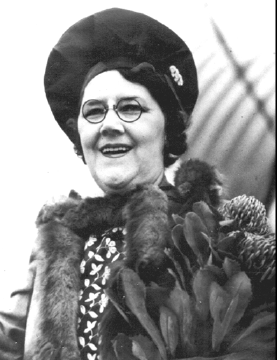 Millicent Preston-Stanley, first woman to be elected to the New South Wales Parliament
Millicent Preston-Stanley, first woman to be elected to the New South Wales Parliament
The brief experiment with proportional representation from multiple-member electorates helped produce New South Wales' first woman Member of Parliament. Although women had received the vote in 1902 they could not stand for the Legislative Assembly until 1918. In 1925 one of the five members elected for the Eastern Suburbs was
Millicent Preston-Stanley, who held the seat for the Nationalist Party 1925-1927. Preston-Stanley was the second woman to be elected to any Parliament in Australia.
Born in 1883, Millicent Preston-Stanley became an active member and organiser in the Women’s Liberal League and other organisations and was appointed one of New South Wales' first women Justices of the Peace in 1921. An effective public speaker, she first stood for Parliament in 1921, succeeding in 1925. In Parliament she campaigned strongly on women’s mortality in childbirth, child welfare, institutional care for mental illness, and custody rights in divorce. In particular, she took up the case of Emélie Polini who lost a custody case because she indicated that she intended to take her child overseas with her. Although Preston-Stanley’s Private Bill on equal custody rights failed, she continued the campaign, even writing and acting in a successful play on the Polini case in 1932. Equal custody rights were achieved with the
Guardian of Infants Act in 1934. Changes to the electorates and voting system resulted in her defeat after contesting the seat of Bondi in 1927 but she continued an active political life, holding many executive positions on women’s organisations and delegations until 1955 when, though terminally ill, she was re-elected President of the Feminist Club.
The second woman to enter the Legislative Assembly was Australian Labor Party (ALP) representative
Mary Quirk who in 1939 won the seat of Balmain following the death of her husband, John, who had been the Member since 1917. She held the seat through three more elections but was defeated in a preselection ballot in 1950. The Assembly also lost its other woman Member that year when
Lilian Fowler (a Lang Labor Member for Newtown since 1944) was defeated in an altered electorate. Fowler had been NSW’s first woman alderman in 1928 and Australia’s first woman mayor (Newtown, 1938).
The first two women appointed to the Legislative Council were both Labor Party members proposed by the second Lang Government on November 23, 1931.
Catherine Green, who took her seat the following day, is regarded as the first woman MLC;
Ellen Webster joining her in the House two days later. Green resigned in September 1932 but Webster remained in the Legislative Council until it was reconstituted in 1933-4. At that time she was placed in an impossible position for the new ballot and commented: “Well, I’ve been dumped but I can still raise a smile”. It was 1952 before another woman (
Gertrude Melville, ALP) was elected to the Legislative Council.
The Legislative Council Under Threat
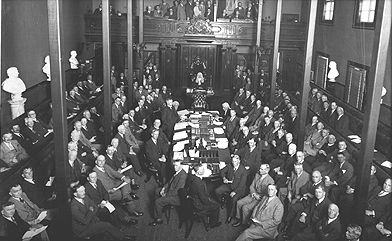 A crowded Legislative Council in session in the 1930s before reform. The wooden posts are preventing the roof from collapsing
A crowded Legislative Council in session in the 1930s before reform. The wooden posts are preventing the roof from collapsing
The Legislative Council of 1856 was to consist of at least 21 Members nominated by the Governor on the advice of his Executive Council, initially appointed for 5 years and thereafter for life. There was no upper limit on the number of Members.
Under the Constitution Act of 1855 the Council had almost the same powers as the Lower House and it originally used them fully. The use of these powers however, was contrary to the growing popular belief that the peoples' will was expressed by the elected Lower House. Council Members originally tended to be prominent wealthy and older citizens with views that were more conservative than most Members of the Legislative Assembly. The Council could amend or reject any Bill sent from the Assembly, even money Bills, causing great frustration to many popularly elected governments. Some governments adopted the practice of stacking the Council with new supportive members when they were having difficulty getting legislation through. The result was a steadily increasing Council which peaked at 125 Members in 1932. Originally Council Members were generally independent, unpaid and operating in an essentially part-time capacity (some rarely attended at all). Increasingly in the twentieth century they became party members.
The Labor Party adopted a platform to abolish the Legislative Council which it saw as essentially conservative and undemocratic. In Queensland in the early 1920s the Upper House was abolished. This spurred the 1925-27 Labor Government of Premier Jack Lang to attempt to abolish the NSW Council. Additional pro-Labor members were appointed, but once in the Council some defected and voted against abolition and the vote was lost. Lang tried again in his second term of office in 1930 but although he got the abolition vote through both houses, a conservative government under T. R. Bavin had altered the Constitution to ensure that abolition could only be done through a referendum, and Lang’s second attempt failed also. Reform of the Council was, however, not far away.
Heroes and Villains
In the twentieth century, Members of Parliament in New South Wales have been remarkably like everyone else in the community – sharing a similar range of personalities, occupations, temperaments, levels of application and honesty with the people who voted for them. Occasional scandals, personal and professional emerged from time to time; corruption and other human and systemic failings occur with Parliament and Parliamentarians as with the rest of the community. But on the whole, New South Wales has been served by reasonable people doing a reasonable job.
Rarely, though, were the human extremes of the personalities, qualities and failings of individual members demonstrated as dramatically as they were by some events linked by a few days in 1922.
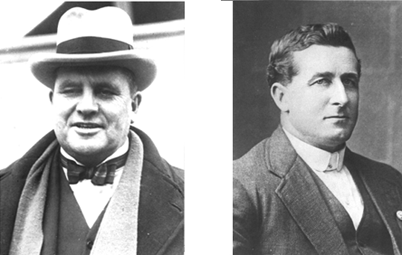
Left: Thomas Ley; right: Percy Brookfield. Contemporary Members of the Legislative Assembly poles apart in character and politics
On 22 March, 1922, the tumultuous career of Percy Brookfield, Labor Member for Sturt since 1916, came to an end. Brookfield, always a strong advocate prepared to resort to his fists under provocation, had troubled the Labor Party almost as much as its opposition with his determination to stand up for his beliefs. On that day, Brookfield was standing on the platform of Riverton Railway Station in South Australia when a crazed gunman, Koorman Tomayeff, opened fire on the incoming train. The local policeman pulled his revolver out to contain Tomayeff but it jammed and the policeman retreated. Brookfield, seeing that the shooting was continuing, took the jammed and useless gun and ran towards Tomayeff to distract him. Although mortally wounded, Brookfield wrestled Tomayeff to the ground, prevented any further shooting and enabling others to capture him.
Three days later, on 25 March, The Hon. Thomas John Ley, was re-elected National Party member for St George, becoming Minister for Justice a fortnight later. Known as “Lemonade” Ley for his prohibitionist stand, Ley constantly demonstrated an unremittingly righteous and harsh interpretation of criminal justice. But all was not as it seemed. Ley resigned from the NSW Parliament in 1925 after one of his opponents, a Mr McDonald, who had been making bribery allegations, permanently disappeared at the time of a scheduled meeting with Ley. Ley then successfully ran for Federal Parliament, becoming Member for Barton from 1925-1928. In 1928 another critic of Ley, Hyam Goldstein, Member for Coogee in the New South Wales Parliament, was found dead at the bottom of a Sydney cliff. As the ring of suspicion tightened around Ley, the upright gentleman suddenly left for Britain in the company of his mistress. Some years later, in 1946, Ley was arrested for arranging the murder of a man he believed was involved with his (now former) mistress. Sentenced to death, he was committed instead to Broadmore Asylum for the Criminally Insane where he died in 1947.
